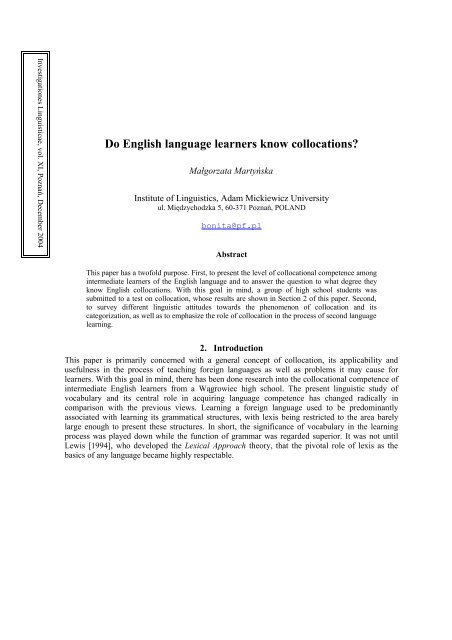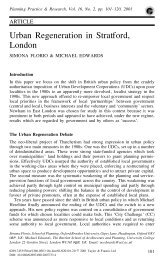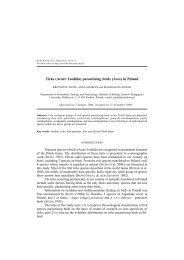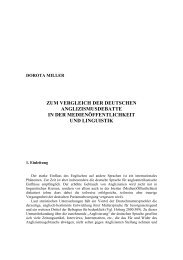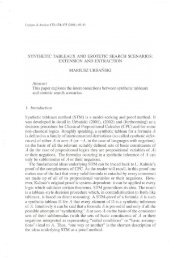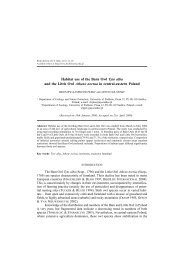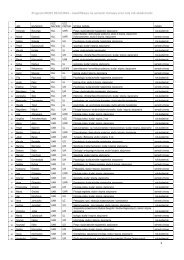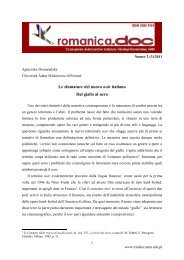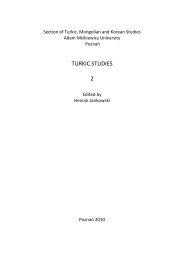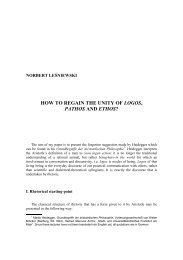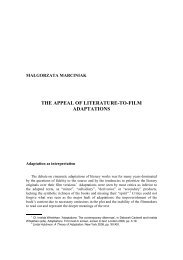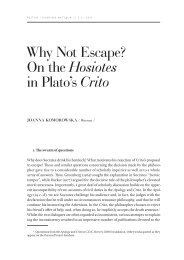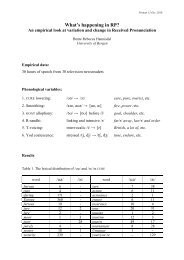Do English language learners know collocations - Investigationes ...
Do English language learners know collocations - Investigationes ...
Do English language learners know collocations - Investigationes ...
You also want an ePaper? Increase the reach of your titles
YUMPU automatically turns print PDFs into web optimized ePapers that Google loves.
<strong>Investigationes</strong> Linguisticae, vol. XI, Poznań, December 2004<strong>Do</strong> <strong>English</strong> <strong>language</strong> <strong>learners</strong> <strong>know</strong> <strong>collocations</strong>?Małgorzata MartyńskaInstitute of Linguistics, Adam Mickiewicz Universityul. Międzychodzka 5, 60-371 Poznań, POLANDbonita@pf.plAbstractThis paper has a twofold purpose. First, to present the level of collocational competence amongintermediate <strong>learners</strong> of the <strong>English</strong> <strong>language</strong> and to answer the question to what degree they<strong>know</strong> <strong>English</strong> <strong>collocations</strong>. With this goal in mind, a group of high school students wassubmitted to a test on collocation, whose results are shown in Section 2 of this paper. Second,to survey different linguistic attitudes towards the phenomenon of collocation and itscategorization, as well as to emphasize the role of collocation in the process of second <strong>language</strong>learning.2. IntroductionThis paper is primarily concerned with a general concept of collocation, its applicability andusefulness in the process of teaching foreign <strong>language</strong>s as well as problems it may cause for<strong>learners</strong>. With this goal in mind, there has been done research into the collocational competence ofintermediate <strong>English</strong> <strong>learners</strong> from a Wągrowiec high school. The present linguistic study ofvocabulary and its central role in acquiring <strong>language</strong> competence has changed radically incomparison with the previous views. Learning a foreign <strong>language</strong> used to be predominantlyassociated with learning its grammatical structures, with lexis being restricted to the area barelylarge enough to present these structures. In short, the significance of vocabulary in the learningprocess was played down while the function of grammar was regarded superior. It was not untilLewis [1994], who developed the Lexical Approach theory, that the pivotal role of lexis as thebasics of any <strong>language</strong> became highly respectable.
<strong>Investigationes</strong> Linguisticae XI3. Various definitions of collocation and their classification3.1. The origin of the word ‘collocation’This term was first introduced by Firth [1957] to define a combination of words associated witheach other, for example to take a photo : zrobić zdjęcie. It is an <strong>English</strong> equivalent of the term‘związek łączliwy’ used by Polish linguists. The term ‘collocation’ has its origin in the Latin verb‘collocare’ which means ‘to set in order/to arrange’. Skorupka [1967] defines ‘związek łączliwy’as a highly cohesive combination of words which are not lexicalized, that is the meaning of thewhole combination is a sum of the meanings of its individual elements, for example dobry,róźowy, świetny, zły humor. He points out that co-occurrence of some words can be determinedand in some cases restricted by their meaning. The adjective gniady refers only to horses so itscollocational range is quite limited. Kania and Tokarski [1984] add that replacing one or twoelements of collocation with a limited number of words is admissible, e.g. rościć prawo/pretensję.3.2. The lexical approach.It is Firth who is widely regarded as the father of collocation and the developer of a lexical and themost traditional approach to this phenomenon. Advocates of the lexical approach claim that themeaning of a word is determined by the co-occuring words. Consequently, lexis is considered to beindependent and separable from grammar. Thus, a part of the meaning of a word is the fact that itcollocates with another word. However, those combinations are often strictly limited, e.g. make anomlette but do your homework while both the verbs do and make have only one Polish equivalentrobić. One of the Firth’s revolutionary concepts was to perceive lexical relations as syntagmaticrather than paradigmatic ones. Sinclair [1966] and Halliday [1966] are Firth’s followers.For Halliday, <strong>collocations</strong> are examples of word combinations; he maintains that collocationcuts across grammar boundaries. For instance, he argued strongly and the strength of his argumentare grammatical transformations of the initial collocation strong argument. In his works hehighlights the crucial role of <strong>collocations</strong> in the study of lexis.Sinclair introduces the following terminology: an item whose <strong>collocations</strong> are studied is calleda ‘node’; the number of relevant lexical items on each side of a node is defined as a ‘span’ andthose items which are found within the span are called ‘collocates’. Later on Sinclair slightlychanges his attitude forming an ‘integrated approach’ and dismisses the previous idea that lexis isrigidly separated from grammar. In this new approach both the lexical and grammatical aspects ofcollocation are taken into consideration. As a result, Sinclair [1991] divides <strong>collocations</strong> into twocategories: the ‘upward’ and ‘downward’ <strong>collocations</strong>. The first group consists of words whichhabitually collocate with the words more frequently used in <strong>English</strong> than they are themselves, e.g.back collocates with at, down, from, into, on, all of which are more frequent words than back.Similarly, the ‘downward’ <strong>collocations</strong> are words which habitually collocate with words that areless frequent than they are, e.g. words arrive, bring are less frequently occurring collocates ofback. Sinclair makes a sharp distinction between those two categories claiming that the elementsof the ‘upward’ collocation (mostly prepositions, adverbs, conjunctions, pronouns) tend to formgrammatical frames while the elements of the ‘downward’ collocation (mostly nouns and verbs) bycontrast give a semantic analysis of a word.2
<strong>Investigationes</strong> Linguisticae XIcollocational continuum is relevant also in regard to lexical <strong>collocations</strong> although they are linkedtogether in a different way than grammatical ones, that is they refer more to semantics.Lewis [2000] argues that most <strong>collocations</strong> are found in the middle of this continuum, whichmeans that there are very few ‘strong’ <strong>collocations</strong>. He makes a distinction between ‘strong’collocation e.g. avid reader, budding author; ‘common’ collocation which makes up numerousword combinations, e.g. fast car, have dinner, a bit tired and ‘medium strong’ one, which in hisview account for the largest part of the lexis a <strong>language</strong> learner needs, e.g. magnificent house,significantly different. Hill adds one more category - ‘unique’ collocation such as to foot the bill,shrug one’shoulders. In terms of the strength of collocation, it is worth noting that it is notreciprocal, which means that the strength between the words is not equal on both sides, e.g. blondeand hair. Blonde collocates only with a limited number of words describing hair colour whereashair collocates with many words, e.g. brown, long, short, mousy. It happens very often that thebond between the words is unilateral, e.g. in the phrase vested interest, vested only ever collocateswith interest but interest collocates with many other words.Hunston [1997] concluded that there are correlations between grammatical patterns andlexical meaning. All words can be represented by specific patterns and the meanings of wordswhich share patterns have a lot in common. That means that a word has a specific meaning when itco-occurs with a certain word. This hypothesis is followed by Hoey [2000], who maintains thatsome meanings of the same word have their own grammatical patterns, which is called‘colligation’. This concept started by Firth is concerned with relationship between grammaticalclasses, whereas collocation is concerned with the words which belong to these grammaticalclasses. Grammatical pattern [verb+to-infinitive] is an example of colligation and [dread+think] isan example collocation of this colligation. In short, colligation defines the grammatical companyand interaction of words as well as their preferable position in a sentence.Another key point in the study of collocation started by Firth is the notion of syntagmatic(horizontal) as opposed to paradigmatic (vertical) relationship between its elements. In thesyntagmatic dimension we can clearly see the relationship between linearly lined up words, whichmake up an individual syntactic unit, here a collocation. In the sentence: It writhed on the floor inagonizing pain the syntagmatic relationship is the one between the words: writhed, floor,agonizing and pain, whereas the paradigmatic relationship is between a word and a group of wordswhich can replace it in this sentence:It writhed on the floor in agonizing pain.bed burningpavement stabbingparadigm1 paradigm2Lewis [1994] defines collocation as a subcategory of multi-word items, made up of individualwords which habitually co-occur and can be found within the free-fixed collocational continuum.In his opinion, they differ from another important subcategory of multi-word items calledinstitutionalized expressions because <strong>collocations</strong> tell more about the content of what a <strong>language</strong>user expresses rather than what the <strong>language</strong> user is doing, e.g. apologizing or denying. Lewis[1997] points out that collocation is not determined by logic or frequency but is arbitrary, decidedonly by linguist convention. Dzierżanowska [1988] adds that words that make up collocation donot combine with each other at random. Collocation cannot be invented by a second <strong>language</strong> user.A native speaker uses them instinctively, e.g. a Polish native speaker <strong>know</strong>s that it is possible tosay wywierać/mieć wpływ but not okazywać/odgrywać. In every <strong>language</strong> <strong>collocations</strong> complywith the rules characteristic of that <strong>language</strong> and therefore they cause serious problems both for<strong>learners</strong> and translators, e.g. osiągnąć cel has two <strong>English</strong> equivalents achieve/reach an aim butosiągnąć porozumienie can be translated with the verb reach but not achieve- reach an agreement.Consequently, <strong>collocations</strong> must be memorized or looked up in an adequate dictionary.Celce-Murcia [1991] defines collocation as a co-occurrence of lexical items in combinations,which can differ in frequency or acceptability. Items which collocate frequently with each otherare called ‘habitual’, e.g. tell a story, whereas those which cannot co-occur are called‘unacceptable’, e.g. *powerful tea instead of strong tea.4
Małgorzata Martyńska: <strong>Do</strong> <strong>English</strong> <strong>language</strong> <strong>learners</strong> <strong>know</strong> <strong>collocations</strong>?Similarly, in Carter’s view [1987], collocation is a group of words that recurrently co-occur ina <strong>language</strong>. He agrees with Benson that there are grammatical <strong>collocations</strong> which result fromgrammatical relationship between the words and lexical <strong>collocations</strong> which result not only fromgrammatical relationship, but most of all from co-occurrence of lexical units in a specificcompany. The total number of words which can collocate with an X word is called a ‘cluster’ of X.He also points out that certain elements of a cluster are more central than other, which means thatthey are more likely to co-occur with X. Carter divides <strong>collocations</strong> into four categories, dependingon how restricted they are: ‘unrestricted’, which collocate freely with a number of lexical items,e.g. take a look/a holiday/a rest/a letter/time/notice/a walk; ‘semi-restricted’, in which the numberof adequate substitutes which can replace the elements of collocation is more limited, e.g. harbourdoubt/grudges/uncertainty/suspicion. The other two categories include ‘familiar’ <strong>collocations</strong>whose elements collocate on a regular basis, e.g. unrequited love, lukewarm reception and‘restricted’ <strong>collocations</strong> which are fixed and inflexible, e.g. dead drunk, pretty sure. Carterdistinguishes between ‘core’ and ‘non-core’ words claiming that the more core a lexical item is,the more frequently it collocates. Core words are more central in a <strong>language</strong> than other, non-corewords and that is why the non-core words can be defined or replaced by the core items, e.g. eat is acore word for gobble, dine, devour, stuff, gormandize because its meaning is the basic meaning ofevery item from the group but this relationship is not reciprocal. In Carter’s view, words arescattered across a core–non-core continuum and their position on this scale determines theircollocability. The nearer to the core end of the continuum a word is, the more frequently itcollocates, e.g. bright >radiant>gaudy:bright: sun/light/sky/idea/colour/red/future/prospects/childradiant: sun/light/smilegaudy: colourAccording to a dictionary definition [Szulc1984], collocation is an ability of lexical items to buildsteady, conventionalized syntagmatic relationship with other words, e.g. putrid, rotten, rancid andaddled are synonyms which designate rotten food but they collocate only with a limited number ofwords: putrid fish, rancid butter/oil, addled eggs, rotten fruit. Individual <strong>collocations</strong> aredetermined by the lexical system of a <strong>language</strong> and can result from historical changes, e.g. inPolish prać rzeczy but myć ręce. The difference is caused by the fact that prać used to mean bić,e.g. /offensive/ sprać kogoś, prać po mordzie. Such <strong>collocations</strong> became a part of the lexicalsystem on the basis of linguist convention, which results in collocational differences between<strong>language</strong>s, although a phenomenon of isomorphism sometimes occurs, e.g. in Polish od czasu doczasu and in <strong>English</strong> from time to time. The most general and commonly accepted definitiondescribes collocation as a lexical company that a lexical item keeps.According to Oxford Collocations Dictionary [2002], collocation is a means of combining wordsin a <strong>language</strong> to produce natural-sounding speech and writing. Incorrect combinations such asheavy wind or strong rain do not sound naturally in <strong>English</strong>. Apart from the prevalentgrammatical/lexical distinction, the authors also mention ‘word’ collocation, none of whoseelements can be replaced even with its synonym, e.g. small fortune but not *little fortune and‘category’ collocation whose elements can collocate with any items of a precisely determinedgroup of words. This group can be quite large and its elements- predictable because they make upthe same category, e.g. measurements of time for a noun walk: five minutes’ walk/three-minutewalk.3.5. Conclusions.Although collocation has become the subject of a linguistic study only recently, it attracts agrowing interest from numerous linguists and is defined in various ways. Accordingly, there is noexhaustive and uniform definition or categorization of collocation. Therefore, it tends to be one ofthe most problematic and error-generating area of vocabulary, especially for second <strong>language</strong><strong>learners</strong>, which can be clearly seen from the results of the tests analyzed in Section 2 of this paper.5
<strong>Investigationes</strong> Linguisticae XI4. Collocational competence of intermediate <strong>English</strong> <strong>learners</strong>.4.1. The subject of this study.This research aims at identifying the level of collocational competence of intermediate <strong>English</strong> <strong>learners</strong>. FiftythreeWągrowiec high school fourth-year students were submitted to a 2-page test, whose results form thebasis of this analysis. They were given four different tasks which involved:I- matching words from column A with their collocates from column B and giving their Polishequivalents1) Przyporządkuj numer z kolumny A do odpowiedniego wyrazu lub wyrażenia z kolumnyB oraz napisz ich polskie odpowiedniki w nawiasach.AB1 - to make [.......……...............] ___ of water [..……....................]2 - to bite [.........…….............] ___ seriously [.....…….................]3 - to mind [......……................] ___ is beating [....……..................]4 - high-heeled [.…….....................] ___ interview [......……................]5 - part-time [....……..................] ___ shoes [............……..........]6 - job [..............……........] ___ your nails [.........…….............]7 - ozone [..........……............] ___ an appointment [....……..................]8 - heart [...........…….……...........] ___ hurt [...............…….......]9 - car [................……......] ___ your own business [.....…….................]10 – a bucket [.............…….........] ___ job [...............…….......]11 - seriously [......……................] ___ layer [............……..........]12 - take it [.........…….............] ___ breaks down [.....…….................]II- completing 3 missing collocates of the central word which belong to specified parts of speech andgiving the Polish equivalent of the central word2) <strong>Do</strong>pisz 3 wyrazy, które mogą współwystępować z podanym wyrazem oraz jego polskiodpowiednik:a. dopisz rzeczownik b. dopisz przymiotnik c. dopiszrzeczownik1.3. TO MAKE[..................]1.2. FOOD[..................]1.1. A PAIR OF[..................]d. dopisz przymiotnik e. dopisz przysłówek f. dopiszczasownik1.6. TOTALLY[..................]1.5. TO WORK[..................]1.4. A CAR[..................]6
Małgorzata Martyńska: <strong>Do</strong> <strong>English</strong> <strong>language</strong> <strong>learners</strong> <strong>know</strong> <strong>collocations</strong>?III- circling the correct option3) Zakreśl właściwą opcję, tak aby zdanie było poprawne.buy1. Yesterday after work I went to M1 to make the shopping.docasual2. I wear common clothes at work.ordinarypain3. I have a terrible tooth discomfort.acheturn off.4. I overslept because my alarm clock didn’t set off.go off.tin5. I bought a can of white paint.mugdifficult6. You work too seriously. You should go on holiday.hardIV- identifying and correcting errors in the underlined part of the sentence4) Poniższe zdania w podkreślonych fragmentach mogą zawierać błędy. Przy zdaniachpoprawnych postaw √ , przy błędnych – X, oraz napisz ich poprawną wersję.1. You never change your brain. You’re so stubborn. ___2. Leszek Miller, the Polish Prime Minister, is a born leader. ___3. For my birthday I got a cook book as a present. ___4. My hair has increased too long. It needs cutting. ___5. I’m pretty exhausted after working in the garden. ___6. You don’t need to dress smartly for this party. ___7. I’ll have a joint of beef for lunch. ___7
<strong>Investigationes</strong> Linguisticae XIAll the instructions were given in Polish to avoid misunderstanding them by the students. In thefirst two tasks students were also additionally asked to give Polish equivalents of the <strong>English</strong>words so as to find out if <strong>know</strong>ing the meaning of a word has something to do with <strong>know</strong>ing itscollocational range. The final question for the students to answer was: ‘How long have you beenlearning <strong>English</strong>? Have you been learning only at school or also in private lessons?’. All testedstudents had a similar level of proficiency in <strong>English</strong> (intermediate) and in class used the sametextbook, on which this test was partly based. The following 7 types of lexical <strong>collocations</strong> wereparticularly focused upon:L1=V+N [verb + noun] e.g. make an appointmentL2=Adj+N [adjective + noun] e.g. high-heeled shoesL3=N+N [noun + noun] e.g. job interviewL4=N+V [noun + verb] e.g. car breaks downL5=Adv+Adj [adverb + adjective] e.g. totally exhaustedL6=Quant+N [quantifier+ noun] e.g. a swarm of beesL7=V+Adv [verb + adverb] e.g. take it seriouslyIt has been attempted to examine which category of those <strong>collocations</strong> the students found mostdifficult and troublesome. The level of difficulty of individual exercises is also taken into accountowing to the fact that some turned out to be easier than other.4.2. The results.Global results, which are given as the round average number of points scored by the students andthe average percentage of correct answers, are presented in the table below:Type of resultsTable 1.Averagenumber ofpointsAveragepercentage ofcorrect answersGENERAL RESULTS24/43 55%KNOWNIG THE MEANING VERSUS KNOWING THE COL. RANGETHE NUMBER OF CORRECT POLISH21/30 71%EQUIVALENTS IN EXERCISES 1 AND 2THE NUMBER OF CORRECT WORD16/30 52%COMBINATIONS IN EXERCISES 1 AND 2RESULTS FROM INDIVIDUAL EXERCISESEXERCISE 1 8/12 64%EXERCISE 2 8/18 43%EXERCISE 3 4/6 72%EXERCISE 4 3/7 46%RESULTS CONCERNING INDIVIDUAL CATEGORIES OF COLLOCATIONSL1 5/8 63%L2 5/8 64%L3 2/3 57%L4 3/7 42%L5 2/5 32%L6 3/6 55%L7 3/6 54%8
Małgorzata Martyńska: <strong>Do</strong> <strong>English</strong> <strong>language</strong> <strong>learners</strong> <strong>know</strong> <strong>collocations</strong>?As far as global results are concerned, the students seem to <strong>know</strong> 55% of all <strong>collocations</strong>, scoring onaverage 24 points out of 43. More than a half of them (31 people) were found above the mean, which isshown in Figure 1 below:10090schoolschool + private lessonsresult [%]80706050403020mean1002 4 6 8 10 12the number of learning yearsFigure 1.What is more, from this chart we can conclude that in this group there is no direct dependence of astudent’s results on the number of years she/he has been learning <strong>English</strong>. Some of the studentswho have been studying for a shorter time scored better, which proves that the efficiency of asecond <strong>language</strong> learning is determined by a number of various factors. In this group most studentswho have attended optional private lessons (marked with red circles in the chart) were found abovethe mean.On the basis of the results from the first two exercises, in which students were additionallyasked to give the Polish equivalents of the <strong>English</strong> words, we can estimate if <strong>know</strong>ing the meaningof a word helps students to match it with its right collocate. The students <strong>know</strong>ing the meaning of71% <strong>English</strong> words were able to identify only 52% of <strong>collocations</strong> made up of these words. Theconclusion is that despite <strong>know</strong>ing the meanings of both elements of a collocation they did notalways succeed in correct matching.Another observation can be made while analyzing the results from individual exercises. Thetask the students found the easiest, scoring 72% of correct answers was exercise 3 which consistedin choosing the right option. The most difficult one turned out to be exercise 2, in which thestudents were asked to give 3 optional words which both collocate with the central word andbelong to the specified part of speech. The students hardly ever provided all 3 words, whichsuggests that they find it easier to match two words in a collocation if they are confronted with agroup of words to choose from (like in exercise 3) than to think of a group of collocates, even assmall as a 3-element one. Even if a student <strong>know</strong>s the Polish equivalent of the central word, he/shefrequently fails to generate its collocates. In some cases the students resorted to their native Polish<strong>language</strong> and its rules, which resulted in producing incorrect <strong>collocations</strong>, e.g. *ride a car [jeździć+ samochód], which in <strong>English</strong> is inadmissible, because ride only collocates with horse or bike.Such combinations as: make homework, make the shopping instead of do homework/the shopping,in which both verbs make and do have the same Polish equivalent robić are also prevalent.The aforementioned 7 categories of lexical <strong>collocations</strong> were also compared in regard to thedegree of difficulty each of them caused. The L1=[v+n] and L2=[adj+n] types, which account for63% and 64% of correct answers respectively appear to be the easiest and the best-mastered ones.This fact is clearly noticeable even in exercise 2, which is said to be the most difficult. The L5=9
<strong>Investigationes</strong> Linguisticae XI[adv+adj] <strong>collocations</strong>, which account only for 32% of correct answers, as well as the L4=[n+v](over 40%) turned out to be a source of serious trouble.L754%L163%L655%L264%L532%L442%L357%Figure 2.5. The role <strong>collocations</strong> play in the process of second <strong>language</strong> teaching.The role <strong>collocations</strong> play in second <strong>language</strong> teaching is integrally related with a conceptintroduced in the 1970s, according to which <strong>language</strong> is learned in a series of pre-fabricated blocksor chunks, defined by Lewis [1994] as unanalyzed wholes. These chunks are said to be the basicdata, by which <strong>learners</strong> identify patterns in a <strong>language</strong>. Previously, this function was attributed togrammar, which was regarded a necessary condition for successful communication. Prendergast(1806-1886) noted that children learn not just words but chunks of a <strong>language</strong>, which they later usefluently in their speech. These chunks seemed to be so well-mastered that the only possibleexplanation of this fact was that they had been memorized as complete units. The children can’thave <strong>know</strong>n grammatical patterns at this stage so the acquisition of these chunks and their ensuingreconstruction resulted from the previous process of imitation and reiteration. It was not howeveruntil over a century later that these observations were appreciated and applied in teachingvocabulary, featuring very largely in the ‘lexical approach’ theory. This approach diverges fromvocabulary traditionally understood as a stock of individual words with fixed meanings andfocuses on the fact that recurrent and ready-made word combinations are the integral elements of alearner’s lexis and produce most of the learner’s texts. Only a minority of spoken sentences areentirely novel creations. Both native speakers and second <strong>language</strong> <strong>learners</strong> are more prone tostore and retrieve whole chunks rather than create them from scratch. Thus, collocation being acategory of such chunks called ‘multi-word’ items plays a crucial role in acquiring foreign<strong>language</strong>.Lewis [1997] in his ‘lexical approach’ theory points out that fluency in a foreign <strong>language</strong> isconditioned by the acquisition of a number of pre-fabricated chunks. He also regards collocation asa central feature of a <strong>language</strong> production. Therefore, students’ attention should be fully directedto it. Lewis [2000] also claims that the number of <strong>collocations</strong> understood as word combinations isgreater than the number of all words because the same words can occur in various <strong>collocations</strong>.That is why <strong>collocations</strong> pose enormous problems, even for the most proficient in <strong>English</strong>.Furthermore, grammar rules are too general to be of any help for students judging whether a10
Małgorzata Martyńska: <strong>Do</strong> <strong>English</strong> <strong>language</strong> <strong>learners</strong> <strong>know</strong> <strong>collocations</strong>?collocation is admissible or not. In consequence, in his view, <strong>collocations</strong> provide more practicaland precise instructions than general grammar rules. Those collocational patterns exemplify somevariants which grammar rules do not embrace, e.g. a usually uncountable noun weather can appearin the collocation out in all weathers in plural. As a result, the usage of collocation determinesprecision and pertinence of the speech. In addition, collocational competence enables students toproduce texts which not only are grammatically correct or merely probable or hypothetical but,inter alia, authentic, which means it is this collocation which a native speaker would use in thisspecific situation. Lewis comes to a conclusion that only by expanding a range of memorizedwhole word combinations it is possible to achieve proficiency level in mastering the syntax of asecond <strong>language</strong>. Collocations also boost the generation of a learner’s lexicon, which is especiallytrue for nouns- every time they are presented in class they should be accompanied by a range ofadjectives and verbs which are their collocates. You will not use a noun in a proper context unlessyou <strong>know</strong> which words co-occur with it. As a result, <strong>know</strong>ing a word cannot be limited to merely<strong>know</strong>ing its meaning; what is crucial is to <strong>know</strong> it collocational range as well.Hill [1999] even suggests coining a term ‘collocational competence’. Learners haveconsiderable difficulty developing collocational competence unless they are able to collocatewords successfully. If in their lexical corpus there are no ready-made chunks at their disposal, theyhave to generate them from scratch on the basis of grammar rules. This leads to numerousmistakes. A wide range of meaningful chunks and <strong>collocations</strong> in the learner’s mental lexiconmakes it possible to quickly find the right word. It also facilitates and accelerates thecommunication process. Szulc [1984] claims that acquisition of <strong>collocations</strong> in a second <strong>language</strong>is fundamental when it comes to gaining <strong>language</strong> competence. Collocational errors are typicaleven of proficient <strong>learners</strong>.According to Nattinger [1980], <strong>language</strong> production is based on piecing together ready-madeunits appropriate for a particular situation. Comprehension of such units depends on <strong>know</strong>ing thepatterns to predict in different contexts. That is why a learner should be instructed in what way andin what cases those units can be combined.Carter [1987] perceive <strong>collocations</strong> as crucial factors of lexical coherence and stresses theneed of teaching collocation at all levels of <strong>language</strong> proficiency.In Celce-Murcia’s view, familiarity with the way words combine is a basic, native-like aspectof learning and using vocabulary. This <strong>know</strong>ledge helps <strong>learners</strong> to encode and decode the<strong>language</strong> following the rule that it is easier to unscramble a message if its elements are highlypredictable.The authors of Oxford Collocation Dictionary [2002] also stress the role of collocation in a<strong>language</strong>, claiming that it runs through the whole of a <strong>language</strong> to such extent that no piece ofnatural spoken or written <strong>language</strong> is totally free of collocation. Every student choosing the rightcollocation makes his/her speech more natural and more native-speaker-like. What is more, a<strong>language</strong> that is colloctionally rich is also more precise because the meaning of a word is alwaysdetermined by the context and it is collocation that provides this context. Thanks to that, <strong>learners</strong>can express more clearly and, at the same time, more precisely the message they want to convey.6. Final conclusions.The analysis of the tests carried out among intermediate <strong>English</strong> <strong>learners</strong> led to a conclusion thattheir results support the hypotheses put forward in the ‘lexical approach’ theory. Learningindividual words and their meaning does not suffice to achieve great fluency in a second <strong>language</strong>.Knowing the way words combine into chunks characteristic of the <strong>language</strong> is imperative.Consequently, if <strong>learners</strong>’ sensitivity to various relations between words is not heightened enoughor words are not learned in chunks, <strong>learners</strong> are not bound to approach the native-like level ofproficiency. Since <strong>learners</strong> do not have many guidelines to follow while considering theadmissibility of collocation, this aspect of every <strong>language</strong> is very problematic. What must not beunderestimated in the process of second <strong>language</strong> teaching is the role of the teacher and thetextbook. From the very beginning, <strong>learners</strong>’ attention should be turned to this kind wordcombinations and students should be constantly acquainted with an increasing number of<strong>collocations</strong>. The richer in <strong>collocations</strong> the learner’s lexicon is, the higher precision, accuracy,11
<strong>Investigationes</strong> Linguisticae XIcoherence and authenticity of his/her speech. This is a perfect way to fluency and proficiency inthe <strong>language</strong> as well as to greater <strong>language</strong> competence.ReferencesBahns, J. 1993. Lexical <strong>collocations</strong>: a contrastive view. ELT Journal, 47(1), 56-63.Benson, M., Benson, E., & Ilson, R. 1997. The BBI Combinatory Dictionary of <strong>English</strong>: A Guide to WordCombinations. John Benjamin Publishing CompanyCarter, R. 1987. Vocabulary. Applied Linguistic Perspectives, London and New York: Routledge.Celce-Murcia, M. 1991. Teaching <strong>English</strong> As A Second or Foreign Language, Heinle & Heinle PublishersDzierżanowska, H. 1988. Przekład tekstów nieliterackich na przykładzie języka angielskiego, Warszawa: PWN.Firth, J. R. 1957. Papers in Linguistics, 1934 – 1951, Oxford: OUP.Firth, J. R. 1957. A Synopsis of Linguistic Theory, 1930-1955 [In:] Studies in Linguistic Analysis.Gitsaki, C. 1996. The Development of ESL Collocational Knowledge. A thesis submitted for a Phd in the Centre forLanguage Teaching and Research at The University of Queenslandwww.cltr.uq.oz.au:8000/users/christina.gitsaki/thesis/contents.htmlHalliday, M. A. K. 1966. Lexis as a linguistic level w C.E. Bazell, J.C.Catford, M.A.K. Halliday & R.H. Robins (Eds.),In memory of J.R. Firth (148-162). London: Longman.Hill, J. 1999. Collocational Competence, ETP April 1999 Issue 11Hoey, M. 2000. A World Beyond Collocation: New Prespectives on Vocabulary Teaching w Teaching Collocation (Eds.)M. Lewis, Hove LTP.Howatt, A. P. R. 1984. A History of <strong>English</strong> Language Teaching, Oxford: OUP.Hunston, S., Francis, G. & Manning, E. 1997. Grammar and Vocabulary: showing the connections, ELT Journal,Volume 51, Issue 3: July 1997.Kania, S. & Tokarski, J. 1984. Zarys leksykologii i leksykografii polskiej, Warszawa: Wydawnictwa Szkolne iPedagogiczne.Kjellmer, G. 1990. Patterns of collocability, [In:] J. Aarts i W. Meijs (Eds.) Theory and Practice in Corpus Linguistics,Amsterdam: Rodopi.Lewis, M. 1994. The Lexical Approach. The State of ELT And A Way Forward, Language Teaching Publications.Lewis, M. 1997. Implementing the Lexical Approach: Putting Theory into Practice, Hove: Language TeachingPublicationsLewis, M. 2000. Teaching Collocation: Further Development in the Lexical Approach, Hove: Language TeachingPublicationsNattinger, J.R. 1980. A Lexical Phrase Grammar for ESL. TESOL Quarterly, 14(3), 337 – 344.Oxford Collocations Dictionary For Students of <strong>English</strong> 2002. Oxford: OUP.Sinclair, J. 1966. Beginning the Study of Lexis, w C.E. Bazell, J.C. Catford, M.A.K. Halliday and R.H. Robins (Eds.): InMemory of J.R. Firth, Longman.Sinclair, J. 1991. Corpus Concordance Collocation, Oxford: OUP.Skorupka, S. 1967. Słownik frazeologiczny języka polskiego, Warszawa: Wiedza Powszechna.Szulc, A. 1984. Podręczny słownik językoznawstwa stosowanego. Dydaktyka języków obcych, PWN Warszawa.Lexis. Chapter 4: From Collocation to Colligation. www.kielikanava.com/chap4.html12


